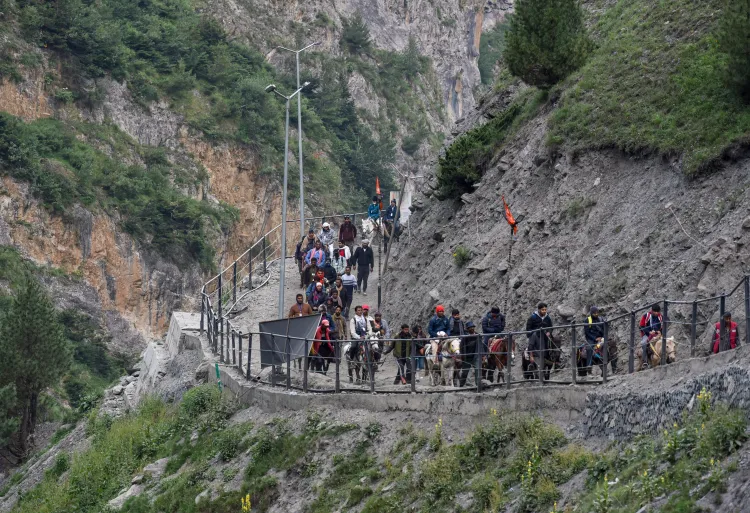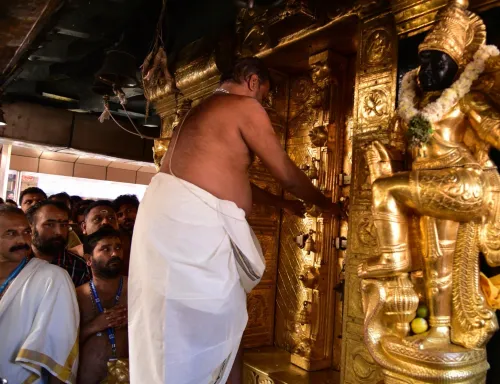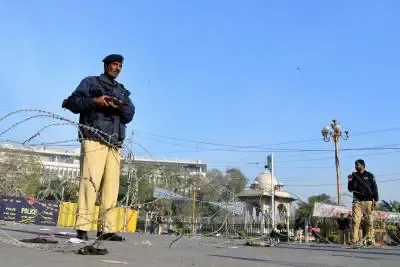Amarnath Yatra: How Many Devotees Have Visited in 12 Days?

Synopsis
Key Takeaways
- Over 2.20 lakh devotees have participated in the Amarnath Yatra.
- Security arrangements include 8,500+ troops for safety.
- The Yatra runs from July 3 to August 9.
- The pilgrimage can be undertaken via two routes: Pahalgam and Baltal.
- The cave shrine features an ice stalagmite representing Lord Shiva.
Srinagar, July 15 (NationPress) A new group of 6,388 pilgrims departed for Kashmir from Jammu on Tuesday as the ongoing Amarnath Yatra sees over 2.20 lakh devotees having completed their ‘darshan’ in the past 12 days.
According to officials, more than 2.20 lakh yatris have participated in the pilgrimage since its commencement on July 3.
Today, another batch of 6,388 yatris left Bhagwati Nagar Yatri Niwas in two escorted convoys. The first convoy of 103 vehicles, carrying 2,501 yatris, departed at 3:26 a.m. heading for the Baltal base camp, while the second convoy of 145 vehicles, with 3,887 yatris, left at 4:15 a.m. for the Nunwan (Pahalgam) base camp,” officials reported.
The meteorological department has predicted widespread light to moderate rainfall in Jammu and Kashmir over the next 24 hours. Officials indicated that the movement of yatris from the two base camps to the holy cave will depend on weather conditions.
The Bhumi Pujan of ‘Chhari Mubarak’ (Lord Shiva’s Holy Mace) was conducted at Pahalgam on July 10. A group of seers, led by the custodian Mahant Swami Deependra Giri, transported the Chhari Mubarak from its location at the Dashnami Akhara Building in Srinagar to Pahalgam.
In Pahalgam, the Chhari Mubarak was taken to the Gauri Shankar temple where the Bhumi Pujan took place. The Chhari Mubarak is set to arrive at the holy cave shrine on August 9, marking the official end of the Yatra.
Extensive security measures have been implemented for this year’s Amarnath Yatra, especially after the tragic attack on April 22, where 26 civilians were killed by Pakistan-backed terrorists in the Baisaran meadow of Pahalgam.
An additional 180 companies of CAPFs have been deployed to strengthen the existing forces, including the Army, BSF, CRPF, SSB, and local police.
The Army has initiated 'Operation SHIVA 2025', deploying over 8,500 troops along with advanced surveillance and combat technologies.
All transit camps along the route to the two base camps and the entire path from Bhagwati Nagar Yatri Niwas in Jammu to the cave shrine are secured.
This year, the Yatra commenced on July 3 and is scheduled to conclude after 38 days on August 9, coinciding with Shravan Purnima and Raksha Bandhan.
Yatris can approach the holy cave shrine, situated at 3,888 meters above sea level in the Kashmir Himalayas, either via the traditional Pahalgam route or the shorter Baltal route. Those taking the Pahalgam route pass through Chandanwari, Sheshnag, and Panchtarni, covering a distance of 46 km on foot, which takes about four days. Conversely, the Baltal route requires a 14 km trek to the cave shrine, allowing return to the base camp the same day after the Yatra.
Due to security reasons, no helicopter services are available for yatris this year.
The cave shrine features an ice stalagmite structure that changes with the lunar phases. Devotees believe this structure represents the mythical powers of Lord Shiva.










